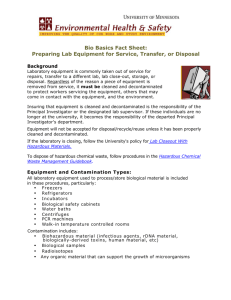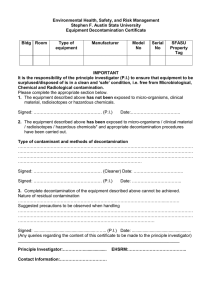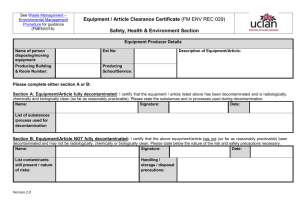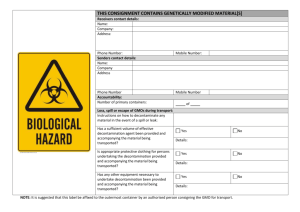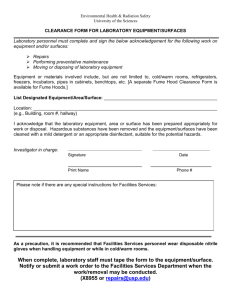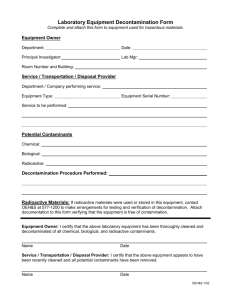SOP042 Decontamination of Animal Rooms and Revision No: Replaces:
advertisement
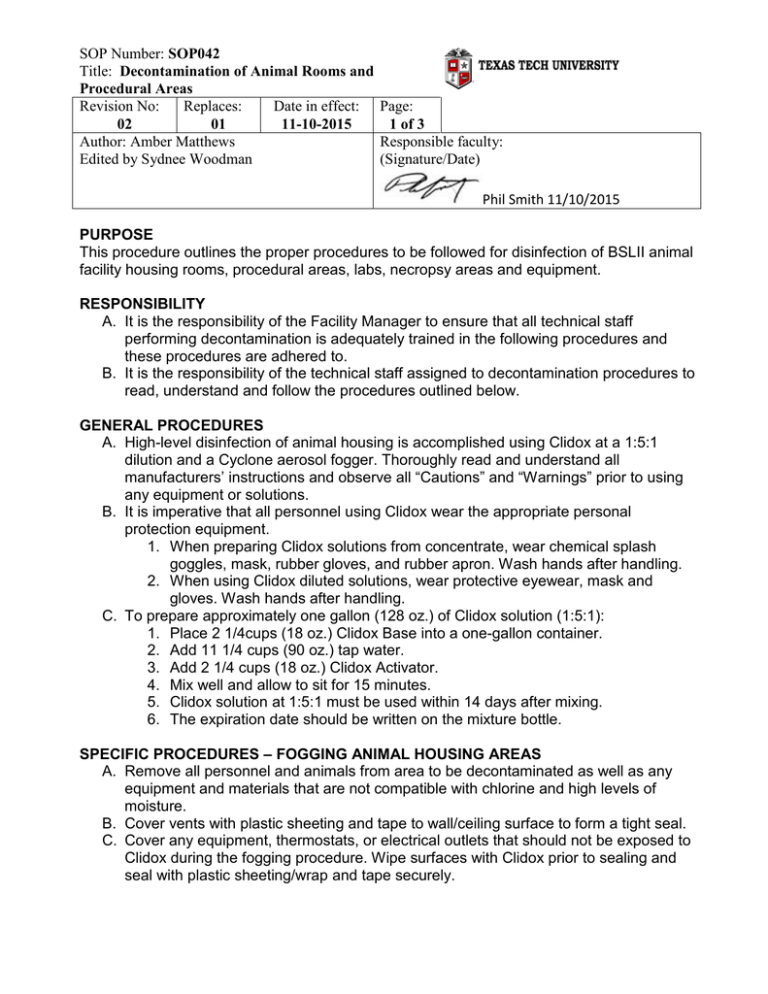
SOP Number: SOP042 Title: Decontamination of Animal Rooms and Procedural Areas Revision No: Replaces: Date in effect: Page: 02 01 11-10-2015 1 of 3 Author: Amber Matthews Responsible faculty: Edited by Sydnee Woodman (Signature/Date) Phil Smith 11/10/2015 PURPOSE This procedure outlines the proper procedures to be followed for disinfection of BSLII animal facility housing rooms, procedural areas, labs, necropsy areas and equipment. RESPONSIBILITY A. It is the responsibility of the Facility Manager to ensure that all technical staff performing decontamination is adequately trained in the following procedures and these procedures are adhered to. B. It is the responsibility of the technical staff assigned to decontamination procedures to read, understand and follow the procedures outlined below. GENERAL PROCEDURES A. High-level disinfection of animal housing is accomplished using Clidox at a 1:5:1 dilution and a Cyclone aerosol fogger. Thoroughly read and understand all manufacturers’ instructions and observe all “Cautions” and “Warnings” prior to using any equipment or solutions. B. It is imperative that all personnel using Clidox wear the appropriate personal protection equipment. 1. When preparing Clidox solutions from concentrate, wear chemical splash goggles, mask, rubber gloves, and rubber apron. Wash hands after handling. 2. When using Clidox diluted solutions, wear protective eyewear, mask and gloves. Wash hands after handling. C. To prepare approximately one gallon (128 oz.) of Clidox solution (1:5:1): 1. Place 2 1/4cups (18 oz.) Clidox Base into a one-gallon container. 2. Add 11 1/4 cups (90 oz.) tap water. 3. Add 2 1/4 cups (18 oz.) Clidox Activator. 4. Mix well and allow to sit for 15 minutes. 5. Clidox solution at 1:5:1 must be used within 14 days after mixing. 6. The expiration date should be written on the mixture bottle. SPECIFIC PROCEDURES – FOGGING ANIMAL HOUSING AREAS A. Remove all personnel and animals from area to be decontaminated as well as any equipment and materials that are not compatible with chlorine and high levels of moisture. B. Cover vents with plastic sheeting and tape to wall/ceiling surface to form a tight seal. C. Cover any equipment, thermostats, or electrical outlets that should not be exposed to Clidox during the fogging procedure. Wipe surfaces with Clidox prior to sealing and seal with plastic sheeting/wrap and tape securely. SOP Number: SOP042 Title: Decontamination of Animal Rooms and Procedural Areas Revision No: Replaces: Date in effect: Page: 02 01 11-10-2015 2 of 3 D. Place fogger on the floor and place in center of room. Run an electrical cord to an outlet outside the area to be fogged. Leave unplugged. E. Pour 1 gallon of Clidox solution (1:5:1) into the formulation tank of the fogger. Turn the machine metering valve to a setting of “4”. Turn fogger power switch to ON. F. Leave room. Plug in power cord to start fogger. Check inside room to ensure machine has started and is functioning by the presence of mist or fog. Seal outer door edges with tape. G. With fogger set on “4”, 20 minutes is needed for adequate coverage. Note: Use full protective wear H. Wait for mist to settle before re-entering room. Check all surfaces in room to be sure that there has been adequate saturation; all surfaces must be damp to the touch to ensure decontamination of room. I. Turn flow valve clockwise to OFF position after each spray application while motor is still operating to clear lines. J. Remove plastic covers and dispose of immediately. K. Wipe all surfaces, such as stainless steel counters, shelves, sinks, etc., with cold tap water. L. Fogged animal housing rooms should be allowed to air out overnight before use. M. Dispose of any used Clidox solution by pouring slowly down a drain while running cold tap water into the drain. 1. Be sure to wear protective wear when doing this. 2. Caution: this does create fumes. N. At the end of each use (or at the end of the day of continuous use), clean fogger applicator with cold tap water. Triple rinse applicator reservoir with tap water. Run applicator with water in well to clear nozzle of residual chemical. SPECIFIC PROCEDURES-FACILITY DECONTAMINATION A. In addition to the above procedures, all racks, shelving units and large animal pens will be sanitized in a rack wash area. B. All plastic caging and small items will be autoclaved if possible and/or sanitized in the cage washer. C. Procedural areas and necropsy areas will be wiped down by hand using Clidox spray (1:5:1). Allow Clidox to remain in contact with surfaces for 5 minutes. Rinse areas clean with cold tap water or 70% Alcohol. D. The clean side of cage wash areas will be decontaminated at least on a monthly basis. The dirty side of cage wash will be decontaminated after it is used for decontaminating large items and at least on a weekly basis. This can be done by spraying walls, floors and equipment with Clidox solution (1:5:1) and allow to sit for 5 minutes; hose down completely. SAFETY CONSIDERATIONS A. When preparing or using Clidox–S Base or Clidox–S Activator the following equipment must be worn. SOP Number: SOP042 Title: Decontamination of Animal Rooms and Procedural Areas Revision No: Replaces: Date in effect: Page: 02 01 11-10-2015 3 of 3 B. C. D. E. 1. Rubber gloves. 2. Chemical splash goggles. 3. Butyl rubber apron. In case of eye contact – flush with water for at least 15 minutes and contact a physician. In case of skin contact – flush with water. Avoid contact with and do not mix with other combustible or acidic substances to prevent the release of Chlorine Dioxide. In case of spills, contain the spill with an absorbent material and notify Environmental Health and Safety for evaluation or instruction. Environmental Health and Safety (806) 742-3876 REFERENCES • Refer to the Dyna-Fog manual for additional fogger information or contact: DYNA-FOG© Customer Service 317-896-2561 • Refer to the Clidox MSDS for additional Chemical information.
